小学英语全英文教案
小学英语教育教学教案设计(精选9篇)

小学英语教育教学教案设计(精选9篇)(经典版)编制人:__________________审核人:__________________审批人:__________________编制单位:__________________编制时间:____年____月____日序言下载提示:该文档是本店铺精心编制而成的,希望大家下载后,能够帮助大家解决实际问题。
文档下载后可定制修改,请根据实际需要进行调整和使用,谢谢!并且,本店铺为大家提供各种类型的经典范文,如总结报告、心得体会、应急预案、会议记录、条据书信、合同协议、规章制度、教学资料、作文大全、其他范文等等,想了解不同范文格式和写法,敬请关注!Download tips: This document is carefully compiled by this editor. I hope that after you download it, it can help you solve practical problems. The document can be customized and modified after downloading, please adjust and use it according to actual needs, thank you!Moreover, our store provides various types of classic sample essays, such as summary reports, insights, emergency plans, meeting minutes, evidence letters, contract agreements, rules and regulations, teaching materials, essay summaries, and other sample essays. If you would like to learn about different sample formats and writing methods, please pay attention!小学英语教育教学教案设计(精选9篇)小学英语教育教学教案设计(精选9篇)2024-04-14 12:07:23小学英语教学设计(精选6篇)推荐度:小学英语教学设计范文最新6篇推荐度:热点范文英语(英文:English)是一种西日耳曼语支,最早被中世纪的英国使用,并因其广阔的殖民地而成为世界使用面积最广的语言。
小学英语教案全英文版
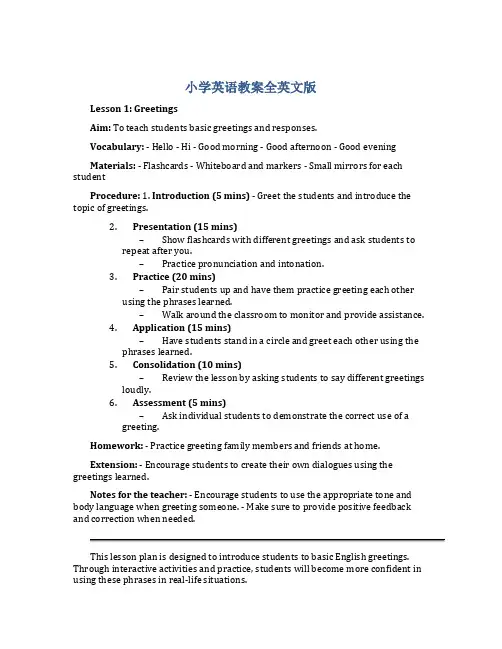
小学英语教案全英文版Lesson 1: GreetingsAim: To teach students basic greetings and responses.Vocabulary: - Hello - Hi - Good morning - Good afternoon - Good eveningMaterials: - Flashcards - Whiteboard and markers - Small mirrors for each studentProcedure: 1. Introduction (5 mins) - Greet the students and introduce the topic of greetings.2.Presentation (15 mins)–Show flashcards with different greetings and ask students to repeat after you.–Practice pronunciation and intonation.3.Practice (20 mins)–Pair students up and have them practice greeting each other using the phrases learned.–Walk around the classroom to monitor and provide assistance.4.Application (15 mins)–Have students stand in a circle and greet each other using the phrases learned.5.Consolidation (10 mins)–Review the lesson by asking students to say different greetings loudly.6.Assessment (5 mins)–Ask individual students to demonstrate the correct use of a greeting.Homework: - Practice greeting family members and friends at home.Extension: - Encourage students to create their own dialogues using the greetings learned.Notes for the teacher: - Encourage students to use the appropriate tone and body language when greeting someone. - Make sure to provide positive feedback and correction when needed.This lesson plan is designed to introduce students to basic English greetings. Through interactive activities and practice, students will become more confident in using these phrases in real-life situations.。
小学英语教案全英文版
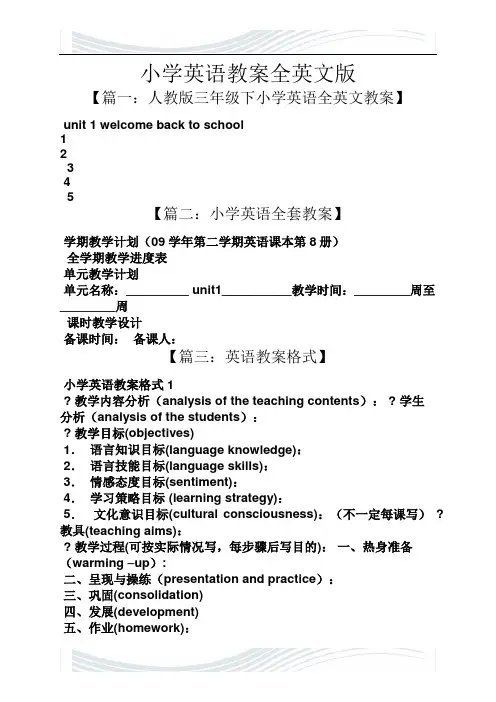
小学英语教案全英文版【篇一:人教版三年级下小学英语全英文教案】unit 1 welcome back to school12345【篇二:小学英语全套教案】学期教学计划(09学年第二学期英语课本第8册)全学期教学进度表单元教学计划单元名称:_________ unit1__________教学时间:________周至________周课时教学设计备课时间:备课人:【篇三:英语教案格式】小学英语教案格式1? 教学内容分析(analysis of the teaching contents): ? 学生分析(analysis of the students):? 教学目标(objectives)1.语言知识目标(language knowledge):2.语言技能目标(language skills):3.情感态度目标(sentiment):4.学习策略目标 (learning strategy):5.文化意识目标(cultural consciousness):(不一定每课写)? 教具(teaching aims):? 教学过程(可按实际情况写,每步骤后写目的):一、热身准备(warming –up):二、呈现与操练(presentation and practice):三、巩固(consolidation)四、发展(development)五、作业(homework):? 板书设计:? 附上练习:范例一:unit3 let’s talk 第一课时小学三年级教学重点:how are you? fine, thank you. 等问候语的学习。
教学难点: 1、how are you? 的得体运用。
2、fine, thank you.中 fine 一词字母 i 的发音不容易到位。
教具准备:1、本课let’s talk/a 部分的教学课件。
2、教师为学生准备3—4个扩音器。
3、本课时教学配套的录音带,以及歌曲“hello”“head, shoulders, knees and toes”的录音带。
全英版小学英语教案【三篇】
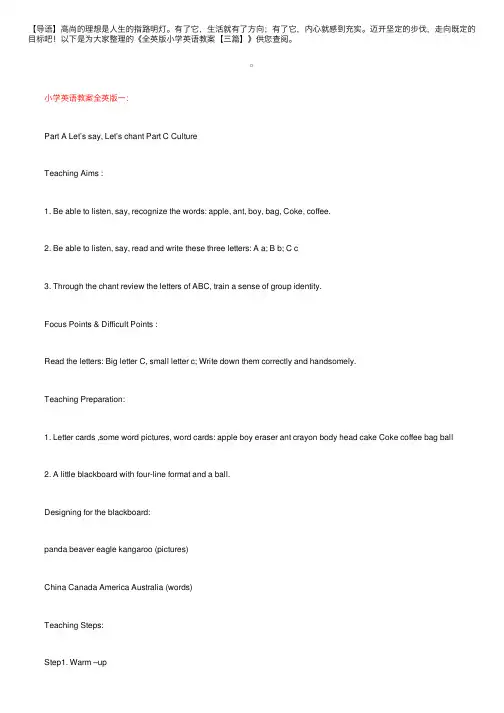
【导语】⾼尚的理想是⼈⽣的指路明灯。
有了它,⽣活就有了⽅向;有了它,内⼼就感到充实。
迈开坚定的步伐,⾛向既定的⽬标吧!以下是为⼤家整理的《全英版⼩学英语教案【三篇】》供您查阅。
⼩学英语教案全英版⼀: Part A Let’s say, Let’s chant Part C Culture Teaching Aims : 1. Be able to listen, say, recognize the words: apple, ant, boy, bag, Coke, coffee. 2. Be able to listen, say, read and write these three letters: A a; B b; C c 3. Through the chant review the letters of ABC, train a sense of group identity. Focus Points & Difficult Points : Read the letters: Big letter C, small letter c; Write down them correctly and handsomely. Teaching Preparation: 1. Letter cards ,some word pictures, word cards: apple boy eraser ant crayon body head cake Coke coffee bag ball 2. A little blackboard with four-line format and a ball. Designing for the blackboard: panda beaver eagle kangaroo (pictures) China Canada America Australia (words) Teaching Steps: Step1. Warm –up 1. Sing a song. 2. Free talk T: Hello. I’m Wendy. I’m from Hangzhou. S1: Hello! I’m ... I’m from Hangzhou,too. T: Nice to meet you. S: Nice to meet you, too. T: Let’s play. Ok? S: Great! T: Watch out! (T throws the ball.) S: Oh, no. Make a similar dialogue with your partner. Step2.Presentation. 1. 1)T : Today, we will learn letters. Do you know letters? Just as A,B,C…… They are letters. What’s the meaning of letters? S: 字母。
小学英语教学教案优秀7篇
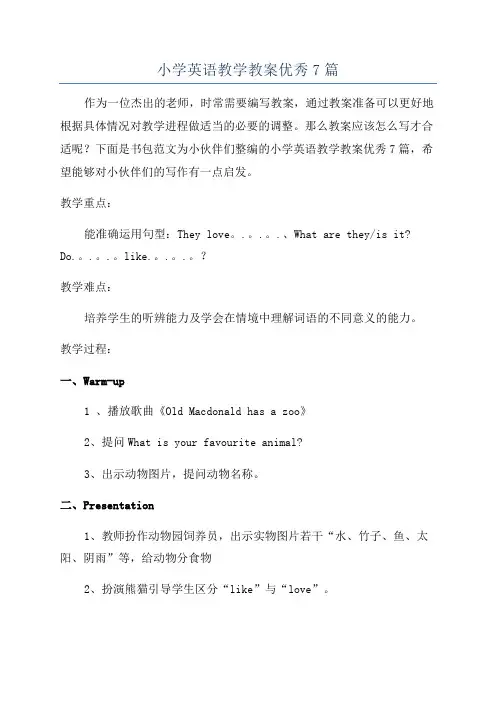
小学英语教学教案优秀7篇作为一位杰出的老师,时常需要编写教案,通过教案准备可以更好地根据具体情况对教学进程做适当的必要的调整。
那么教案应该怎么写才合适呢?下面是书包范文为小伙伴们整编的小学英语教学教案优秀7篇,希望能够对小伙伴们的写作有一点启发。
教学重点:能准确运用句型:They love。
.。
.。
.、What are they/is it? Do.。
.。
.。
like.。
.。
.。
?教学难点:培养学生的听辨能力及学会在情境中理解词语的不同意义的能力。
教学过程:一、Warm-up1 、播放歌曲《Old Macdonald has a zoo》2、提问What is your favourite animal?3、出示动物图片,提问动物名称。
二、Presentation1、教师扮作动物园饲养员,出示实物图片若干“水、竹子、鱼、太阳、阴雨”等,给动物分食物2、扮演熊猫引导学生区分“like”与“love”。
3、出示天气图片,通过对天气的喜爱程度,引导学生运用“like”与“love”。
三、Practice1、听活动一录音完成动物特征和喜好表格。
2、依据表格进行谜语创作。
四、Consolidation1、播放录音,让学生体会语调。
2、引导学生小组设计一组就动物习性进行的谈话,用准确的语调展示。
五、Summary引导学生整理本模块内容,介绍所学内容。
板书设计:Module7 Unit2 Pandas love bamboo。
Snakes love the sun。
What are they? Elephants like the water.They are.。
.。
.。
Pandas love bamboo.Dogs play with children.Cats like fish.一、设多彩情景,创课堂氛围众所周知,英语是一种语言,而非一般的知识。
语言的学习如果脱离了一定的情境,学生学习起来不但吃力,更不能很好地把握知识的用法。
小学五年级英语上册教案全英文版5篇
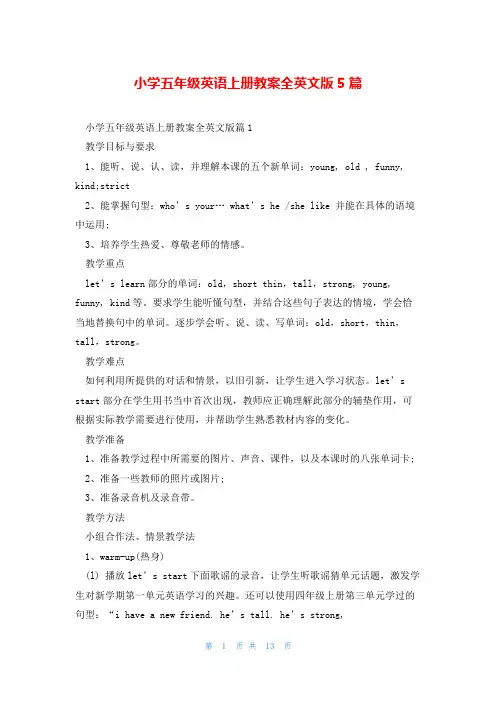
小学五年级英语上册教案全英文版5篇小学五年级英语上册教案全英文版篇1教学目标与要求1、能听、说、认、读,并理解本课的五个新单词:young, old , funny, kind;strict2、能掌握句型:who’s your… what’s he /she like 并能在具体的语境中运用;3、培养学生热爱、尊敬老师的情感。
教学重点let’s learn部分的单词:old,short thin,tall,strong, young, funny, kind等。
要求学生能听懂句型,并结合这些句子表达的情境,学会恰当地替换句中的单词。
逐步学会听、说、读、写单词:old,short,thin,tall,strong。
教学难点如何利用所提供的对话和情景,以旧引新,让学生进入学习状态。
let’s start部分在学生用书当中首次出现,教师应正确理解此部分的辅垫作用,可根据实际教学需要进行使用,并帮助学生熟悉教材内容的变化。
教学准备1、准备教学过程中所需要的图片、声音、课件,以及本课时的八张单词卡;2、准备一些教师的照片或图片;3、准备录音机及录音带。
教学方法小组合作法、情景教学法1、warm-up(热身)(l) 播放let’s start下面歌谣的录音,让学生听歌谣猜单元话题,激发学生对新学期第一单元英语学习的兴趣。
还可以使用四年级上册第三单元学过的句型:“i have a new friend. he’s tall. he’s strong,too.”并结合相关人物的图片,引导学生复习 strong, tall, short,thin等词,为本课时听、说、读、写这些单词做好准备。
(2)日常口语练习,内容可参考如下:t:hello, everyone! welcome back to school! nice to see you!ss: nice to meet you!(3) 问学生几个问题,引出本课重点内容。
小学pep英语教案5篇
小学pep英语教案5篇pep小学英语全英教案设计篇一一、教学内容:本册书共六单元,课本内容共分六部分:Unite 1 My ClassroomUnite 2 My SchoolbagUnite 3 My FriendsUnite 4 My HomeUnite 5 What Would You Like?Unite 6 Meet My Family!二、教材分析为确保良好的教学效果,在教学新内容时要强调听准,辩清,观察,模仿,练习运用。
即:听音--仔细静听;辩音--辨清发音;观察--注意观察;模仿--认真模仿;练习--积极练习;运用--实际运用;课堂练习A----活动手册它是本套教材教科书的主要组成部分,与课本同步进行。
B----单元练习每单元课后用一课时巩固前面内容。
录音带,投影片和教学挂图,音标卡片,字母卡片,教学图片。
这些辅助材料,均为配合课本的系列辅助材料,不仅可以帮助教师有效的进行教学,而且可以活跃课堂气氛,增加学生学习英语的兴趣。
三、教学目的1、对于有一年学习基础的学生要求进一步提高,加强儿童对英语的感性知识,激发他们学习英语的兴趣和培养能力,使学生敢于大胆开口说英语,在理解的基础上表演英语。
2、打下较好的'语音,语调和书写基础。
3、养成良好的书写习惯,根据单词的拼写和发音规则认读和拼写单词。
四、重点难点:1、四会单词的教学。
2、每一课的会话的表演。
3、四会单词的拼写。
Unit 1单元分析一、教学内容1、本单元要求会听,说,认读的单词:window board light picture door floor classroom computer wall teachers desk fan what in the we have new go where2、本单元要求会听,说的单词和词组:many our seat near classmate cleanhave a look good idea all right good job3、帮助学生在掌握单词的基础上造出句子,编出对话,学以致用。
小学英语教案20篇英文版
小学英语教案20篇英文版小学英语教学是教育的基础,也是每一个孩子学习英语的开端。
为了帮助小学英语老师更好地开展教学工作,提高孩子的英语学习成绩,以下是20篇小学英语教案的英文版,供广大小学英语教师参考。
1. Title: Introducing MyselfContent: Students learn to introduce themselves in English.Objectives: By the end of the class, students should be able to introduce themselves inEnglish.Materials: PPT, pictures, handoutsProcedure:1. Warm-up: Greeting students and asking them about their names.2. Presentation: Using pictures to introduce oneself and providing examples.3. Practice: Students practice introducing themselves in pairs.4. Production: Students present themselves in front of the class.5. Evaluation: Checking students’ pronunciation and fluency.2. Title: ColorsContent: Students learn how to recognize and say different colors in English.Objectives: By the end of the class, students should be able to recognize and name different colors in English.Materials: PPT, flashcards, handoutsProcedure:1.Warm-up: Using colored flashcards to engage students.2. Presentation: Using PPT to show pictures of different colors and their names.3. Practice: Students match the colors with their names and practice saying them.4. Production: Students createtheir own pictures and describe them in English.5. Evaluation: Checking students’ ability to recognize and name different colors.3. Title: NumbersContent: Students learn how to recognize and say the numbers from 1 to 20 in English.Objectives: By the end of the class, students should be able to recognize and say the numbers from 1 to 20 in English.Materials: PPT, flashcards, handoutsProcedure:1. Warm-up: Using number flashcards to engage students.2. Presentation: Using PPT to show pictures of the numbers from 1 to 20 and their names.3. Practice: Students match the numbers with their names and practice saying them.4. Production: Students practice counting in English and count the number of objects in the classroom.5. Evaluation: Checking students’ ability to recognize and say the numbers from 1 to 20.4. Title: ShapesContent: Students learn how to recognize and name different shapes in English.Objectives: By the end of the class, students should be able to recognize and name different shapes in English.Materials: PPT, flashcards, handoutsProcedure:1. Warm-up: Using shape flashcards to engage students.2. Presentation: Using PPT to show pictures of different shapes and their names.3. Practice: Students match the shapes with their names and practice saying them.4. Production: Students create their own pictures using different shapes and describe them in English.5. Evaluation: Checki ng students’ ability to recognize and name different shapes.5. Title: FamilyContent: Students learn how to talk about their family members in English.Objectives: By the end of the class, students should be able to talk about their family members in English.Materials: PPT, flashcards, handoutsProcedure:1.Warm-up: Asking students about their family members.2. Presentation: Using PPT to show pictures of different family members and their names.3. Practice: Students practice talking about their family members in pairs.4. Production: Students present their family members in front of the class.5. Evaluation: Checking students’ ability to talk about their family members in English.6. Title: AnimalsContent: Students learn how to recognize and name different animals in English.Objectives: By the end of the class, students should be able to recognize and name different animals in English.Materials: PPT, flashcards, handoutsProcedure:1. Warm-up: Using animal flashcards to engage students.2. Presentation: Using PPT to show pictures of different animals and their names.3. Practice: Students match the animals with their names and practice saying them.4. Production: Students create their own pictures using different animals and describe them in English.5. Evaluation: Chec king students’ ability to recognize and name different animals.7. Title: WeatherContent: Students learn how to recognize and name different types of weather in English.Objectives: By the end of the class, students should be able to recognize and name different types of weather in English.Materials: PPT, flashcards,handoutsProcedure:1. Warm-up: Asking students about the weather outside.2. Presentation: Using PPT to show pictures of different types of weather and their names.3. Practice: Students practice recognizing and naming different types of weather.4. Production: Students describe the weather in a particular place.5. Evaluation: Checking students’ ability to recognize and name different types of weather.8. Title: Food and DrinksContent: Students learn how to recognize and name different types of food and drinks in English.Objectives: By the end of the class, students should be able to recognize and name different types of food and drinks in English.Materials: PPT, flashcards, handoutsProcedure:1.Warm-up: Asking students about their favorite food and drinks.2. Presentation: Using PPT to show pictures of different types of food and drinks and their names.3. Practice: Students practice recognizing and naming different types of food and drinks.4. Production: Students decide on a menu and describe the food and drinks in English.5. Evaluation: Checking students’ ability to recognize and name different types of food and drinks.9. Title: My BodyContent: Students learn how to recognize and name different parts of the body in English.Objectives: By the end of the class, students should be able to recognize and name different parts of the body in English.Materials: PPT, flashcards, handoutsProcedure:1. Warm-up: Asking students about different parts of the body.2. Presentation: Using PPT to show pictures of different parts of the body and their names.3. Practice: Studentspractice recognizing and naming different parts of the body.4. Production: Students draw a person and label the different parts of the body in Eng lish.5. Evaluation: Checking students’ ability to recognize and name different parts of the body.10. Title: JobsContent: Students learn how to recognize and name different types of jobs in English.Objectives: By the end of the class, students should be able to recognize and name different types of jobs in English.Materials: PPT, flashcards, handoutsProcedure:1. Warm-up: Asking students about their dream job.2. Presentation: Using PPT to show pictures of different types of jobs and their names.3. Practice: Students practice recognizing and naming different types of jobs.4. Production: Students choose a job and describe it in English.5. Evaluation: Checking students’ ability to recognize and name different types of jobs.11. Title: Days of the WeekContent: Students learn how to recognize and say the days of the week in English.Objectives: By the end of the class, students should be able to recognize and say the days of the week in English.Materials: PPT, flashcards, handoutsProcedure:1. Warm-up: Asking students about their favorite day of the week.2. Presentation: Using PPT to show pictures of the days of the week and their names.3. Practice: Students practice recognizing and saying the days of the week.4. Production: Students describe their schedule for the week.5. Evaluation: Checking students’ ability to recognize and say the days of the week.12. Title: Months of the YearContent: Students learn how to recognize and say the months of the year in English.Objectives: By the end of the class, students should be able to recognize and say the months of the year in English.Materials: PPT, flashcards, handoutsProcedure:1. Warm-up: Asking students about their favorite month of the year.2. Presentation: Using PPT to show pictures of the months of the year and their names.3. Practice: Students practice recognizing and saying the months of the year.4. Production: Students describe their favorite season and the months that belong to it.5. Evaluation: Checking students’ ability to recognize and say the months of the year.13. Title: TimeContent: Students learn how to tell the time in English.Objectives: By the end of the class, students should be able to tell the time in English.Materials: PPT, flashcards, handoutsProcedure:1. Warm-up: Asking students about their favorite time of the day.2. Presentation: Using PPT to show pictures of the clock and different times.3. Practice: Students practice telling the time in English.4. Production: Students plan their daily schedule and write it in English.5. Evaluation: Checking students’ ability to tell the time in English.14. Title: Weather ForecastContent: Students learn how to give a weather forecast in English.Objectives: By the end of the class, students should be able to give a weather forecast in English.Materials: PPT, flashcards, handoutsProcedure:1.Warm-up: Asking students about the weather outside.2. Presentation: Using PPT to show different weather conditions andvocabulary.3. Practice: Students practice giving a weather forecast in pairs.4. Production: Students give a weather forecast in front of the class.5. Evaluation: Checking students’ ability to give a weather forecast in English.15. Title: SeasonsContent: Students learn how to recognize and name the different seasons in English.Objectives: By the end of the class, students should be able to recognize and name the different seasons in English.Materials: PPT, flashcards, handoutsProcedure:1. Warm-up: Asking students about their favorite season.2. Presentation: Using PPT to show pictures of the different seasons and their names.3. Practice: Students practice recognizing and naming the different seasons.4. Production: Students write a paragraph about their favorite season in English.5. Evaluation: Checking students’ ability to recognize and name the different seasons in English.16. Title: ToysContent: Students learn how to recognize and name different types of toys in English.Objectives: By the end of the class, students should be able to recognize and name different types of toys in English.Materials: PPT, flashcards, handoutsProcedure:1. Warm-up: Asking students about their favorite toy.2. Presentation: Using PPT to show pictures of different types of toys and their names.3. Practice: Students practice recognizing and naming different types of toys.4. Production: Students describe their favorite toy in English.5. Evaluation: Checking students’ ability to recognize and name different types of toys.17. Title: School SuppliesContent: Students learn how to recognize and name different school supplies in English.Objectives: By the end of the class, students should be able to recognize and name different school supplies in English.Materials: PPT, flashcards, handoutsProcedure:1. Warm-up: Asking students about their favorite school supply.2. Presentation: Using PPT to show pictures of different school supplies and their names.3. Practice: Students practice recognizing and naming different school supplies.4. Production: Students describe the contents of their school bag in English.5. Evaluation: Checking students’ ability to recognize and name different school supplies.18. Title: Parts of a HouseContent: Students learn how to recognize and name different parts of a house inEnglish.Objectives: By the end of the class, students should be able to recognize and name different parts of a house in English.Materials: PPT, flashcards, handoutsProcedure:1.Warm-up: Asking students about the different rooms in their house.2. Presentation: Using PPT to show pictures of different parts of a house and their names.3. Practice: Students practice recognizing and naming different parts of a house.4. Production: Students describe their favorite room in their house in English.5. Evaluation: Checking students’ ability to recognize and name different parts of a house.19. Title: HolidaysContent: Students learn how to recognize and name different holidays in English.Objectives: By the end of the class, students should be able to recognize and name differentholidays in English.Materials: PPT, flashcards, handoutsProcedure:1. Warm-up: Asking students about their favorite holiday.2. Presentation: Using PPT to show pictures of different holidays and their names.3. Practice: Students practice recognizing and naming different holidays.4. Production: Students write about their favorite holiday in English.5. Evaluation: Checking students’ ability to recognize and name different holidays in English.20. Title: SportsContent: Students learn how to recognize and name different sports in English.Objectives: By the end of the class, students should be able to recognize and name different sports in English.Materials: PPT, flashcards, handoutsProcedure:1. Warm-up: Asking students about their favorite sport.2. Presentation: Using PPT to show pictures of different sports and their names.3. Practice: Students practice recognizing and naming different sports.4. Production: Students describe their favorite sport in English.5. Evaluation: Checking students’ ability to recognize and name different sports in English.以上是20篇小学英语教案的英文版,它们覆盖了小学英语教学的各个方面。
小学生英语教案精选5篇
小学生英语教案精选5篇小学生英语教案【篇1】一教学内容1.词汇(略)。
2.句型:Its time to do sth.3.语法:初步学习不可数名词的用法。
二教具录音机;与本课生词有关的图片;几只茶杯(或瓶子玻璃杯)。
三课堂教学设计1.值日生报告。
2.放课文第一段录音,教师先提一个问题:Whats the time? 放一遍录音,学生回答教师的问题。
再放录音,学生跟读两遍。
教师解释对话中 Its time to…这一句话,并板书以下时间和动词短语:7∶30 go to school 8∶00 go to the classroom4∶00 play games 5∶00 go home 10∶00 go to bed要求学生利用所给时间和动词短语,编小对话。
例如:S1:Its 7∶30 now.S2:Oh, its time to go to school.S1:OK, lets go!S2:Yes, lets.其他对话形式同上。
3.利用准备好的图片(如果没有,可利用课本中插图),教本课词汇。
在学生基本会读以后,教师解释rice,tea等不可数名词在使用中的注意事项,并借助事先准备好的茶杯等实物,引导出 cups of tea等短语,借助图片,引导出 some rice等,以增加直观效果。
打开练习册,指导学生用笔头形式做习题2。
4.教师可反复利用手中实物或图片,不断变换,要求学生用英语表达:T:(举起一碗米饭的图片)Ss:Some riceT:(换成几只茶杯)Ss:three cups of tea (four, five etc.)这个练习可集体与个人形式相结合。
5.指导学习做练习册其他习题。
6.布置作业1)抄写生词;2)完成练习册习题。
四难点讲解a cup of tea 一杯茶tea, milk, orange, water等词是不可数名词,本身没有复数形式。
要表示它的量的多少,可借助 a cup/bottle/glass of等短语。
小学英语全英教案(17篇)
小学英语全英教案(17篇)篇1:全英教案篇5:小学英语全英说课稿篇9:小学英语全英说课稿篇10:小学英语全英说课稿I’ll finish this lesson in five steps。
step1 lead--in activitiesI will begin my class with “drawing and guessing” game,just like this : I show students some vehicles such as bike ,bus ,jeep which they learned before by “Stick Figures” and ask them guess what’s it。
Purpose: It is important to form a better English learning surrounding for the Ss by guessing game。
and at the same time it provides situations to review learned knowledge for the next step。
step2 prestentationNow I’ll mainly talk about this step。
1、first there is a Free talk between T and Ss。
For example: I show many pictures of beautiful cities and ask students some questions,such as “do you like this city?where do you want to go ?”and help Ss to answer them with “by train ,by plane,by ship”。
- 1、下载文档前请自行甄别文档内容的完整性,平台不提供额外的编辑、内容补充、找答案等附加服务。
- 2、"仅部分预览"的文档,不可在线预览部分如存在完整性等问题,可反馈申请退款(可完整预览的文档不适用该条件!)。
- 3、如文档侵犯您的权益,请联系客服反馈,我们会尽快为您处理(人工客服工作时间:9:00-18:30)。
小学英语全英文教案小学英语全英文教案Theme: DiscussionFunction: Presenting different points of view.Target Language: What do you suggest? What about …? Why don't you …? How about…?I think so. I don't think so.Vocabulary: suggest, quickly, excited, America, Chinese, kind, dragon, same, circlePronunciation: / / / / / / / /Poem: Do you agree?一、Warmer:1. Draw some pictures to help the Ss to learn the words: some chopsticks, a dragon, a kite, a radio, a CD2. Put the pictures on the board, then the teacher call out the names of the pictures and let the Ss point them.二、Presentation:1. Look, listen and learn:A. Tell the Ss that you are going to play a dialogue. The Ss have to listen and tell you what things they are thinking of giving to the cousin.B. They have to listen to the objects that are suggested in the text.C. Tell the Ss to close their books. Play the dialogue and get the Ss to listen and note down their answers. Then ask them what objects they heard were mentioned.D. Tell the Ss to open their books and read through the text and underline the objects that were suggested.E. Read the dialogue:1) Daming will visit his ( cousin).2) He lives in (America).3) His mother is (Chinese).4) Daming won't take (chopsticks).5) He will take ( a kite).6) The present is ( a Chinese dragon kite).2. Make suggestions:I want to buy a present foe my brother.That's a good idea.What about a bag/ a T-shirt/ a book/ a football?I agree.三、Activity book:Listen and complete the text:Chinese dragon kiteChinese dragon kites are very famous. They are very beautiful. People love them all over the world. Some dragon kites are small. One person can fly them. Others are very big. You need lots of people of fly them. They are very long. Don't fly them near trees or houses.四、Homework:Read the text. 2. Talk about 'What do you suggest?' 小学英语全英文教案Theme: LibraryFunction: How to research informationTarget Language: Where are …about…? …in two weeks' time. Where can you find out about…? Where can you find out about…? You can find out about …in/on…Vocabulary: library, find, CD-ROM, bring, use, card, easy, information,timetable, dictionary, newspaperPronunciation: / / / /Poem: Let's go to the library.一、Warmer:1. Read the text of Unit 1 and spell the new words.2. The teacher explain some of the words to the Ss. Newspaper/ dictionary/cookery book/ timetable/words and meanings/ news/ train times/ food recipes3. Make some sentences with' Let's…We can…Where …please They are…‘二、Presentation:1. Listen and say:A. On the board write the following: newspaper/ timetable/ dictionary/ CD-ROM/ library/ find outA. Let the Ss close their books and listen to the tape and choose the words from the board.B. Play the dialogue again and get the Ss to repeat the sentences.and answer:A. Where can you find out about sports? On TV.B. Where can you find out about games?C. Where can you find out about toys?D. Where can you find out about food?E. Where can you find out about China?F. Where can you find out England?2. Listen and repeat:Die lie / high night / girl shirt/ / ie / / igh / / ir三、Activity Book:1. Look and complete:A. You can read information in a book or in a newspaper.B. You can get information on the radio.C. You can see and hear information on a CD-ROM.D. You can get information about the weather on TV.E. You can find out about train information in a timetable.F. You can find out about English in a dictionary.2. Listen and repeat:A. The panda will lie down but not die.B. At night, the moon is high in the sky.C. This girl is wearing a blue shirt.四、Homework: 1. Read the text of Unit 2. 2. Write some sentences with' Where can you find out about…I can find out …小学英语全英文教案Theme: Letters from Abroad Function: Understanding different cultures.Target Language: Simple past tense. The man wore women's clothes. The actors told lots of jokes. We laughed a lot. Simple future tense 'be going to' We are going to see you in three weeks. Mum bought newchopsticks for you.Vocabulary: wore (wear), women, actor, told (tell), joke, funny, after, show,ready, soon, bed, room, history, question, borrow, eveningPronunciation: / / / / / / / /Song: Postman, Postman一、Warmer:1. Tell the Ss that you are going to say some verbs in the present from and then say the same verbs in the past from. Get the Ss to repeat them after you.2. Write all the verbs on the board.Have wentMeet lostIs ateLose hadEat wasGo went3. Get the Ss to work in pairs. One student says the verb in the present tense from and the other says the verb in the past form.二、Presentation:1. Look, listen and learn:A. Listen to the tape and underline the verbs in past tense form. (went, wore, told, laughed, women, actor, joke, funny, after, show, ready)B. Play the dialogue again and answer the questions:1) Where did Lingling go last week?2) What did the men and the women wear?3) What did the actors do?4) Where did they go after the show?5) What did they eat?C. Listen to the text and complete?Dear Daming:Last week we went to a children's theatre . The man wore women's clothes . The women wore men's clothes. The actors told lots of jokes . It was very funny.We laughed a lot. English children love the theatre.After the show we went to a restaurant. We all ate hamburgers and chips.Are you ready for your trip to America?From,Lingling2. Look and say.A. Ask and answer: What did he do last night?He watched TV.He played computer games.He ate an apple/ sweets.He played toys.He drank some milk.He read books.三、Activity book:Listen and write some sentences:1) Xiaoyong went to a party yesterday.2) He wore a beautiful sweater.3) He said 'Happy birthday' to his friend.4) His friend gave him a birthday hat.5) They played games together happily.6) They ate a big birthday cake.7) They were very happy.四、Homework:1. Read the text.2. Remember the new words.。
